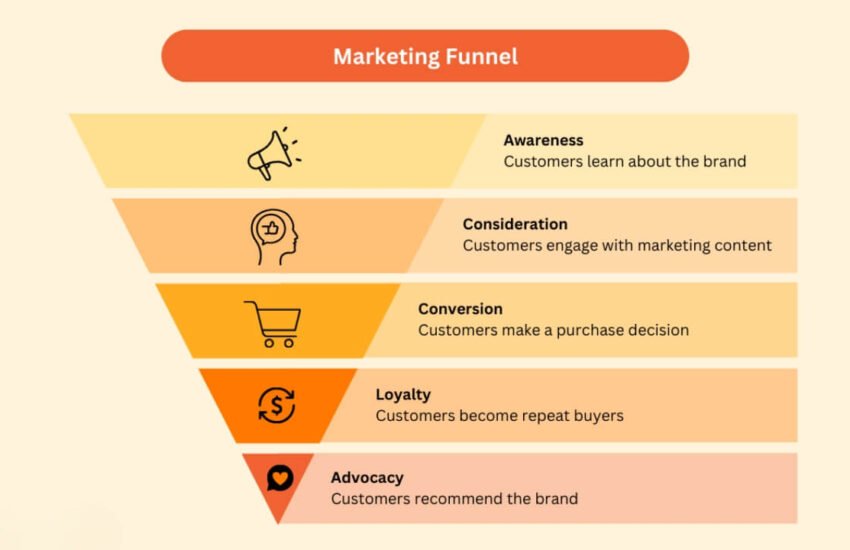In the modern business environment, where there is a lot of competition in the digital sphere, it is important to learn and improve your work through the marketing funnel to maximize your conversion and increase revenue. But, as every marketer understands, potential customers frequently abandon you at some stage and you wonder which stage this happens at and circumstances in which you have to address the issue. This article will take you through how to identify the conversion killer points in a funnel, mapping the road blocks on the path to conversions and how to transform your funnel numbers into a quick action insight that will generate revenues.
Knowing Marketing Funnel
Before discussing the problem of expensive drop-offs in your funnel and the ways to fix them, you need to learn more about a marketing funnel and its functioning. The marketing funnel represents the process that the potential customers pass through before making a purchase and it mostly consists of following key points:
- Awareness: The level of being familiar with your brand by a potential customer.
- Interest: Their activities or make direct visits to significant pages of your web content.
- Consideration: They try to find answers to their problem, contrast or seek a demonstration.
- Purchase: When they become paying customers at last.
- Retention: It is the period after a purchase during which the customer is willing to make a purchase, may upgrade, or may refer new people.
What popped up is that it is critical to understand the movement of the users across these phases and their point of drop off that can be used to increase funnel conversions and overall performance. If you draw your funnel stages properly, you can be sure to have a thematic platform of analysis.
If you look at the costly drop-offs then you will see where you are losing the customers.
Drops in your marketing funnel are a given, but what is important is to know where drop-offs are occurring in order to convert as many as possible. In many cases, minor adjustments in the funnel can lead to huge revenues. This is how to go about identifying costly drop-offs and correct them:
Start With Conversion Rate Analysis
Analysis of the conversion rate is the key to funnel optimization. You can also calculate conversion rates between each stage of your funnel in order to figure out where prospects are being lost. As an example, by looking at the number of visitors landing in your product page, and the number that requests a demo, it might end up indicating a 5% conversion rate. You can then compare conversion rates from the various sources of traffic generated, and this will help you to identify what works and what does not.
Whereas in eCommerce tracking the views on products, their addition to the cart and the check out process will enable you to distinguish where the greatest exits occur. In the case of lead generation funnels, you would need to review submitted forms, pages visited, and interaction.
Get into Drop-Off Analysis
When you recognize the locations where users are losing, you are able to look at individual pages or stages that have such high exit rates. Use such analytics tools as Google Analytics or Hotjar to get more insight into the most abandoned pages.
You can go back to the above solution as an example with an issue such as users dropping off your product page without taking any items to the cart, then the following remedies apply:
- Review there is high-quality picture and a well-written product description.
- Have reviews, social proof, easy-to-note trust signals.
- Ensure that the customer experience during checkout is quick and does not present too many distractions.
Multi-Step Funnel Analysis of Lead Generation
Lead generation funnels are even more complicated because users may go through a multi-step process. It is important to closely monitor the user through the landing page, through the form fields, to the form submission in order to identify the friction points.
With the assistance of such tools as Microsoft Clarity or Hotjar, you will have exposure to where users take action or stall, and it will be a great indicator of what leads to the drop-off. Are they quitting in a midway stage of the form? Is it the case that they leave without viewing a video that is important? The heatmaps are able to offer solutions
Carrying out Cohort Analysis to reveal LongTerm Trends
Cohort analysis can also be used to monitor the progress of groups of users and can tell you something useful about performance of your funnel. You can compare users who visited in January to users who visited in March to determine whether there are seasonal trends or long-term behavior changes which seem to be occurring.
B2B customers and B2C customers have a tendency of behaving very differently. B2B customers prefer to convert during the working days whereas B2C customers are active during the weekends. With the data segmented in this manner, your efforts can be better directed and your funnel adjusted depending on these distinctive trends.
Use Data to identify Trends
Do not depend on vanity metrics only but split your data into practical insights. Analyze trends (the conversion rates are high at some particular hours of the day or certain traffic sources). When the conversion rate of users on one channel is high as compared to that on another channel, then you can allocate more resources to the higher-performing channel.
What to Do with Funnel Data to Value It
The process of collecting data and performing analyses of your funnel is only the beginning. The actual question is to convert these insights into the strategies that can bring more conversions.
Seal those Holes that Are Most Expensive
It can be tempting to do everything possible to optimize each part of the funnel, but it is better to be selective in terms of investing your efforts in the points with the greatest drop-offs. To successfully focus on the significant problems, apply a Pareto Principle (80/20 rule) to solve the problems that will make the biggest difference to your bottom line.
An example of that is when users are getting to the checkout page but then they leave. Then it could bring quick results if enhancement of the checkout process is done. This can be accomplishing compliance to include clarifying payment methods, minimizing distractions or providing incentives such as free shipping to drive conversions.
Test A/B on important pages
When you have determined the step at which the drop-offs are taking place, it is time to conduct tests. A/B testing provides you the ability to test out various versions of landing pages, contact forms, or even the given funnel steps. Minor adjustments such as altering the call-to-action or more streamlining the form can generate significant outcomes.
Monitor and Readjust on a Regular Basis
Funnel analysis is not a one off duty- it is continuous activity. Set up dashboards that can measure key funnel metrics and that may be reviewed on a regular basis. The behavior of the users will shift and new trends will appear, so it is vital to remain flexible and keep trying and testing.
The Appropriate Tools to Use in Funnel Analysis
To have an overall picture of what is happening to your marketing funnel, you require the appropriate tools to collect data, drop out analysis, and progress measurement over time. The following are some of the tools that can assist:
- Google Analytics 4: Includes funnel tracking and setting up your conversion goals to keep track of the customer journey.
- Hotjar or Microsoft Clarity: Analytics tool that gives heatmaps and recordings of user sessions, as well as on-page behavior insight.
- HubSpot, Salesforce (RM Platforms): Will enable you to identify lead conversion and information after lead closures.
- Amplitude or Mixpanel: Powerful event tracking and segmenting when your funnel is complex.
Conclusion: Strategies on How to Eliminate Expensive Losses and Enhance Your Sales Channel
Diagnosing drop-offs Subtypes of drop-off Diagnosing drop-offs You are going to vehicle.com and the vehicle.com domain is having trouble with its DNS. Conversion rate analysis, drop-off analysis, and cohort analysis are just three of the many possible analyses that can give you the verbal data you need to be able to recognize points of friction and act to improve the performance of your funnel.
Maximize the actions that are most likely to result in an outcome, do A/B tests regularly and utilize the appropriate software to measure and change your funnel as it evolves. Having such strategies in place, you will be in a good position of increasing conversions, improving revenues as well as creating an effective marketing funnel that will result in sustained growth.
you may also like
WooCommerce Plugin Bug: How to Secure Your Site Against the New Customer Review Vulnerability



